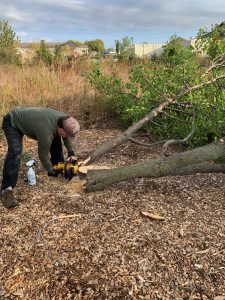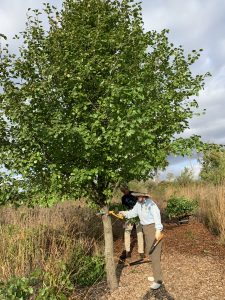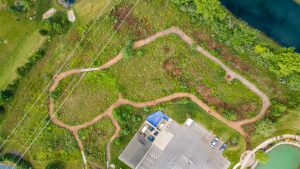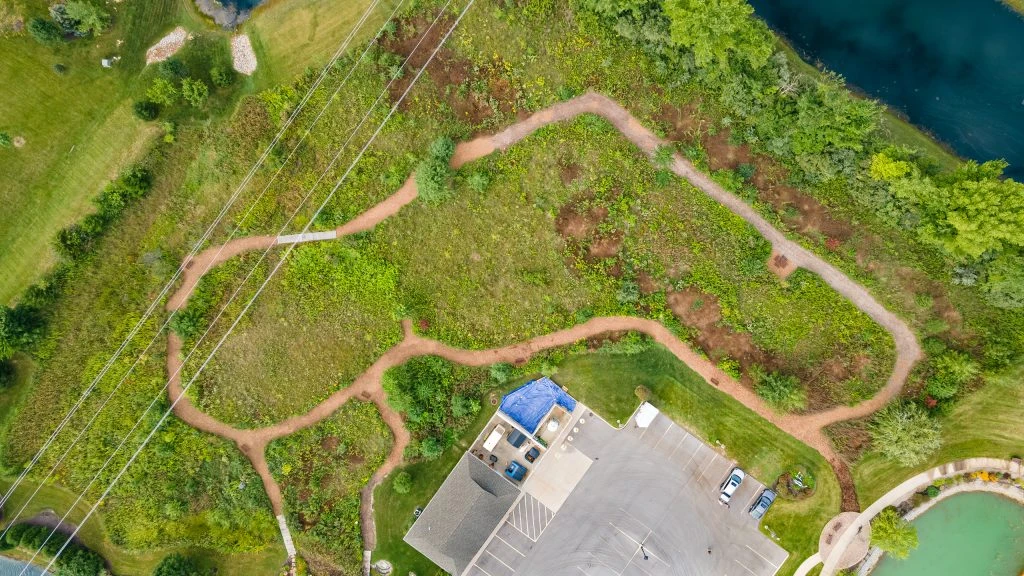


The two-acre Stillwater prairie situated behind Hospice Home was planted 16 years ago to provide a natural place of comfort and inspiration to the families of our patients, our staff members, and to community neighbors. Only native Indiana prairie grasses and flowers were planted with the goal of restoring another parcel of Hoosier land to its native state to benefit the wildlife that depends upon native species.
As can happen on any land, though, invasive species moved in and started to overtake native plants. Invasives get an edge by greening earlier and continuing to grow longer than natives. They are aggressive and propagate quickly. By 2021, the prairie was overrun.
Stillwater volunteer John Gevers, who had gained solace by walking the prairie in 2014 while his family kept vigil at his mother’s bedside in Hospice Home, offered to develop and lead a multi-year project to restore the prairie to its natural native state, and a dedicated team of ten volunteers miraculously formed. The “Prairie Posse” worked with invasive species specialists, Indiana Master Naturalists, staff from Little River Wetlands Project, and original installers of the prairie—Heartland Restoration to give the boot to over 500 (and counting) invasive trees, shrubs, and plants and BAE Systems employees volunteered to lay down fresh mulch during United Way Day of Caring 2021. The City of Fort Wayne donated a dumpster to get rid of the removed invasives.
European settlers arriving in Indiana found Native Americans using controlled fires every few years to keep native prairie land healthy. Native plants have much longer root systems than invasive species plants which allow them to easily survive fire and drought conditions, as well as to absorb more water and better filter ground water. They also provide seeds, nectar, and shelter that native animals and pollinators depend upon. The low-to-the-ground prescribed burns quickly kill off shallower-rooted invasive species and deposit carbon onto the ground that the sun’s rays can then reach, which collectively encourages native plants to thrive.
There wasn’t time or money to carry out a prescribed burn in spring of 2022, so the Stillwater prairie was brush-cut and the resulting “duff”—or thatch—was raked and removed from the prairie to give the native species a fresh start this spring. The United Way of Allen County staff took on a Day of Caring itself and descended upon the prairie to help remove much of the duff. Areas where invasives were removed last year have now been planted with 160 donation-funded flowering plants and grasses representing nine species that were not found among 30 other native species of grasses and flowers already growing.
Restoration efforts were rewarded this spring when a pair of Killdeer birds nested in the prairie, bringing four chicks into the landscape. Other wildlife observed in the prairie include prized monarch butterflies, bees, praying mantises, deer, mink, coyotes, hawks, Sandhill Cranes, bald eagles, and songbirds.
The removal of some invasive species will take 3-5 years given their growth habits, which explains why portions of the prairie will remain inactive while the seed bed is sterilized. Gevers, who has since been hired as part-time groundskeeper for the Stillwater campus and is now a certified Indiana Master Naturalist, continues to oversee the prairie and urges “patience while enjoying the prairie and its pathways during the process.” Additional volunteers are needed to join the effort and are encouraged to send an email to [email protected] .



